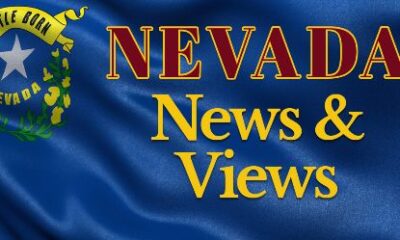(Samantha Stone) – If Nevada’s financial health were a jigsaw puzzle, the $3 billion budget shortfall facing the next legislature would be the biggest piece. It’s the focal point in the picture. But it’s only one piece of the puzzle.
By the time the 2011 legislature convenes, the business community will be wrestling with another big piece — paying back more than half a billion dollars borrowed from the federal government for benefits to unemployed Nevadans. As that repayment drags on, a second obligation will hang in the background — replenishing the state’s own unemployment fund, which has been dry since last fall when the jobless rate hit 13 percent.
Nevada’s debt to the feds has mounted as the ranks of its unemployed swelled. The weekly payout rose to $40 million, with borrowed funds reaching $414 million this week. By the end of the year, the state’s Employment Security Division estimates it will have borrowed between $500 and 800 million. The debt will climb steadily toward a billion during 2011, and could hit $1.8 billion by the end of 2013.
Whatever remedy lawmakers deliver next year to patch the state budget hole, it will likely be piled on top of a hefty increase in the state unemployment tax rate. That’s because the nine-member Employment Security Council is fairly certain to hand down a rate increase when it meets this fall, after deciding last year to leave the rate alone in light of the tough economic climate.
By all accounts, that rate must rise this time, and it can’t, practically speaking, rise enough to allow us to quit the borrowing. The state’s unemployment rate has just reached 14 percent, giving Nevada the dubious distinction of replacing Michigan as the state with the highest unemployment. For as long as unemployment remains high, Nevada will pay out more in benefits than it collects for that purpose, and the borrowing will continue.
The governor’s Deputy Chief of Staff Stacy Woodbury likens Nevada to a distressed household.
“We’re basically living on credit cards right now,” said Woodbury. “We’re making monthly payments on a balance that continues to grow, and accrue interest.”
Repayment will take years, and may not be complete even by the time the next recession hits. (Downturns are somewhat predictable, historically occurring every eight years.) Moreover, Nevada’s own empty unemployment trust fund can’t be rebuilt until the borrowed funds are repaid.
Unemployment funding: FUTA, SUTA, It’s all Uncle Sam’s LOOT-A
The unemployment tax paid by business is technically two taxes. The Federal Unemployment Tax (FUTA) is imposed by the federal government, to pay for the administration of the state programs. The SUTA tax is the state portion, a revenue stream that goes into Nevada’s own benefit trust fund, and can be used only for unemployment benefits.
At a certain point, FUTA will increase if Nevada hasn’t paid back its loan.
“One way or another, the federal government is going to make themselves whole,” said Cindy Jones, Administrator of the Employment Security Division. “Either we pay them back or they charge employers more in the FUTA tax.”
The state can try to minimize the federal increases by meeting certain benchmarks that set up conditions for repayment. It’s a tricky calculation, according to Jones, to begin at the state level to raise the tax enough to start digging out of the hole. But fiscally responsible behavior can lead to a cap on the FUTA increase.
And then there’s the interest. Nevada’s first interest payment – an estimated $60 million — comes due in September of 2011. That payment will apply to funds borrowed in the first nine months of 2011. For bookkeeping purposes, those interest payments on the borrowed money will become a third fund, since that money must be kept separate from the unemployment insurance taxes.
“We have to set up a whole separate assessment system to charge the employers for the funds to pay the federal interest,” said Jones.
All of the money collected, though, goes to the federal government, and the state’s fund remains empty until the debt is repaid.
No interest is due on the 2010 loans. A provision of the federal stimulus package deems interest on 2010 unemployment loans to the states to have been paid.
Thirty-two states, $38 billion
Nevada is not alone. Thirty-two states owe approximately 38.1 billion dollars. All of them started borrowing long before Nevada did.
When this great recession began, the state boasted the 18th strongest unemployment trust fund in the nation. Nevada was able to pay benefits for many months without borrowing at all. By the time Nevada needed its first loan from the feds, its unemployment rate had reached second-highest among the states. Meanwhile thirty other states had already been borrowing, with a few starting when unemployment was still as low as 4 percent.
“We came into this recession positioned pretty well,” said Jones. “By federal measures we were right at what they would expect us to have in reserve.”
Jones and staff attribute this strength at least in part to “forward funding,” a counter-cyclical approach to managing the fund. During prosperous times, tax rates are raised to build reserves. During a bust, they don’t have to be raised.
Nevada officials were confident last year that the fund would withstand a medium-intensity recession. But nobody predicted the severity of the downturn. By the end of 2009, the fund was upside down.
The tax rate decision
The Employment Security Council is appointed by the governor. It’s comprised of 3 members of the public, 3 labor representatives, and 3 from the business community. In October, the council meets to consider the solvency of the state trust fund, and the rate for the following year. The council hands down a recommendation to Jones, and as the administrator of the program, she may accept or reject it.
The average tax rate paid by Nevada employers today is 1.33 percent of the first $27,000 earned by an employee. The rate applied to the individual employer varies, based on the extent to which the state fund has been affected in the past by employee turnover from that business. Current rates range from .25 to 5.4 percent.
In January, one month before the legislature starts a session that may spawn a significant batch of new taxes, business will begin to pay the new unemployment tax rate. No speculation about how much higher that rate will be.
“How much of an increase are they willing to absorb at this point in order to work toward paying back our loans and building our balance?” Jones asked. “The longer we string (it) out… the higher the federal tax will be, the more interest will have to be.”
(Ms. Stone writes and publishes the Reasonable Reporter blog. You can access it at http://reasonablereporter.wordpress.com)




Facebook
Twitter
Pinterest
RSS